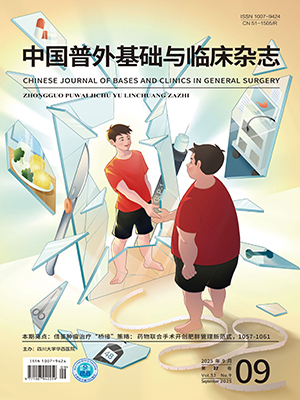| 1. |
Siegel RL, Miller KD, Jemal A. Cancer statistics, 2018. CA Cancer J Clin, 2018, 68(1): 7-30.
|
| 2. |
Wang X, Lu X, Geng Z, et al. LncRNA PTCSC3/miR-574-5p governs cell proliferation and migration of papillary thyroid carcinoma via Wnt/β-catenin signaling. J Cell Biochem, 2017, 118(12): 4745-4752.
|
| 3. |
Chereau N, Giudicelli X, Pattou F, et al. Diffuse sclerosing variant of papillary thyroid carcinoma is associated with aggressive histopathological features and a poor outcome: results of a large multicentric study. J Clin Endocrinol Metab, 2016, 101(12): 4603-4610.
|
| 4. |
Blomberg M, Feldt-Rasmussen U, Andersen KK, et al. Thyroid cancer in Denmark 1943-2008, before and after iodine supplementation. Int J Cancer, 2012, 131(10): 2360-2366.
|
| 5. |
李伟, 潘燕, 李学军. HER2 阳性乳腺癌治疗药物曲妥珠单抗耐药机制及新一代靶向药物研究进展. 中国临床药理学杂志, 2014, 30(1): 48-51.
|
| 6. |
Lu P, Weaver VM, Werb Z. The extracellular matrix: a dynamic niche in cancer progression. J Cell Biol, 2012, 196(4): 395-406.
|
| 7. |
Wang L, Zhao L, Jia X, et al. Aminophenols increase proliferation of thyroid tumor cells by inducing the transcription factor activity of estrogen receptor α. Biomed Pharmacother, 2019, 109: 621-628.
|
| 8. |
黑利娟, 王娟红, 魏威, 等. 乳头状甲状腺癌患者血清和甲状腺组织中白细胞介素 6 水平的检测及其意义. 吉林大学学报 (医学版), 2019, 45(3): 601-605.
|
| 9. |
Xiao M, Hu S, Tang J, et al. Interleukin(IL)-21 promoter polymorphism increases the risk of thyroid cancer in Chinese population. Gene, 2014, 537(1): 15-19.
|
| 10. |
Santarpia L, El-Naggar AK, Cote GJ, et al. Phosphatidylinositol 3-kinase/akt and ras/raf-mitogen-activated protein kinase pathway mutations in anaplastic thyroid cancer. J Clin Endocrinol Metab, 2008, 93(1): 278-284.
|
| 11. |
Levin-Salomon V, Livnah O, Engelberg D. A “molecular evolution” approach for isolation of intrinsically active (MEK-independent) MAP kinases. Methods Mol Biol, 2010, 661: 257-272.
|
| 12. |
Hong H, Zhou T, Fang S, et al. Pigment epithelium-derived factor (PEDF) inhibits breast cancer metastasis by down-regulating fibronectin. Breast Cancer Res Treat, 2014, 148(1): 61-72.
|
| 13. |
Kenny HA, Chiang CY, White EA, et al. Mesothelial cells promote early ovarian cancer metastasis through fibronectin secretion. J Clin Invest, 2014, 124(10): 4614-4628.
|
| 14. |
Jeon M, Lee J, Nam SJ, et al. Induction of fibronectin by HER2 overexpression triggers adhesion and invasion of breast cancer cells. Exp Cell Res, 2015, 333(1): 116-126.
|
| 15. |
周艳, 罗枫, 伍世钢, 等. TPO、HBME-1、CK19、Galectin-3、CyclinD1 检测在甲状腺良恶性病变中的鉴别诊断价值. 海南医学, 2020, 31(1): 27-30.
|
| 16. |
傅晓丹, 楼善贤, 施红旗, 等. 甲状腺微小乳头状癌 254 例临床病理分析. 中华病理学杂志, 2015, 44(4): 258-261.
|
| 17. |
Zhang W, Sun W, Qin Y, et al. Knockdown of KDM1A suppresses tumour migration and invasion by epigenetically regulating the TIMP1/MMP9 pathway in papillary thyroid cancer. J Cell Mol Med, 2019, 23(8): 4933-4944.
|
| 18. |
Buitrago D, Keutgen XM, Crowley M, et al. Intercellular adhesion molecule-1 (ICAM-1) is upregulated in aggressive papillary thyroid carcinoma. Ann Surg Oncol, 2012, 19(3): 973-980.
|
| 19. |
崔演, 刘胜男, 张佰玲, 等. 甲状腺乳头状癌组织中 ICAM-1 的表达及意义. 临床与实验病理学杂志, 2013, 29(6): 655-657.
|
| 20. |
Ramirez R, Hsu D, Patel A, et al. Over-expression of hepatocyte growth factor/scatter (HGF/SF) and the HGF/SF receptor (cMET) are associated with a high risk of metastasis and recurrence for children and young adults with papillary thyroid carcinoma. Clin Endocrinol (Oxf), 2000, 53(5): 635-644.
|
| 21. |
郑炳行, 师天雄, 邓建伟. C-MET 蛋白在甲状腺癌合并颈部淋巴结转移的研究. 中国医药科学, 2013, 3(9): 26-27, 43.
|
| 22. |
龚婷, 王家东, 钱敏飞, 等. 相对定量 real time RT-PCR 检测 Runx2 mRNA 在甲状腺乳头状癌中的表达. 临床耳鼻咽喉头颈外科杂志, 2013, 27(4): 193-195.
|
| 23. |
Han M, Chen L, Wang Y. miR-218 overexpression suppresses tumorigenesis of papillary thyroid cancer via inactivation of PTEN/PI3K/AKT pathway by targeting Runx2. Onco Targets Ther, 2018, 11: 6305-6316.
|
| 24. |
Wang X, Xu X, Peng C, et al. BRAFV600E-induced KRT19 expression in thyroid cancer promotes lymph node metastasis via EMT. Oncol Lett, 2019, 18(1): 927-935.
|
| 25. |
An J, Yang J, Lee WH, et al. Diagnostic Kit of breast cancer via urine microbiome. Eur J Surg Oncol, 2020, 46(2): e33.
|
| 26. |
Vierlinger K, Mansfeld MH, Koperek O, et al. Identification of SERPINA1 as single marker for papillary thyroid carcinoma through microarray meta analysis and quantification of its discriminatory power in independent validation. BMC Med Genomics, 2011, 4: 30.
|
| 27. |
An HJ, Koh HM, Song DH. Apolipoprotein E is a predictive marker for assessing non-small cell lung cancer patients with lymph node metastasis. Pathol Res Pract,, 2019, 215(10): 152607.
|
| 28. |
Asare GA, Owusu-Boateng E, Asiedu B, et al. Oxidised low-density lipoprotein, a possible distinguishing lipid profile biomolecule between prostate cancer and benign prostatic hyperplasia. Andrologia, 2019, 51(8): e13321.
|




